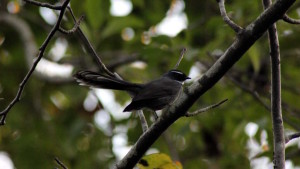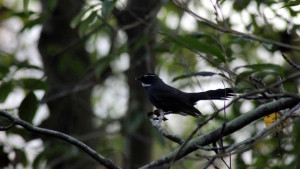
Rhipidura albicollis ( White-throated fantail )
The White-throated Fantail (Rhipidura albicollis) is a small, agile bird commonly seen fluttering through the understory of the Great Himalayan National Park (GHNP). Recognized by its broad, fan-shaped tail and white throat patch, this energetic bird is a favorite among birdwatchers exploring the forested zones of the park’s Sainj and Tirthan valleys.
Habitat and Behavior in GHNP
In GHNP, the White-throated Fantail typically inhabits broadleaf forests and scrub-covered slopes between 1,200 and 2,800 meters in elevation. It is particularly fond of dense foliage near water sources and shaded ravines, where it can often be seen flicking its tail in a rhythmic dance.
The bird is highly active and vocal, often moving rapidly through low branches and shrubs in search of small insects. Its foraging behavior includes short, darting flights to capture flying insects, along with leaf-turning and probing.
Vocalizations and Social Interactions
One of the most distinctive features of Rhipidura albicollis is its varied and melodious song, which it repeats in fast, complex phrases. During the breeding season, the male uses its song to mark territory and attract mates. The species is generally solitary or seen in pairs, though it may join mixed feeding flocks in winter.
| Common name | White-throated Fantail |
| Scientific name | Rhipidura albicollis |
| Family | Rhipiduridae |
| Description | It is a resident bird of Himalayas and having narrow white supercilium and white throat; lacks spots on wing coverts. It has white –spotted grey breast and buff belly. It is commonly seen in an altitude of 2000m and prefers forest and wooded areas for their living. |
Nesting and Conservation
The White-throated Fantail constructs a small cup-shaped nest using moss, spider webs, and plant fibers, usually suspended from a low branch. It lays 2–4 eggs, and both parents contribute to incubation and chick-rearing.
While this bird is listed as a species of Least Concern globally, its presence in GHNP underscores the park’s rich avian diversity and the importance of conserving subtropical and temperate forest ecosystems.




